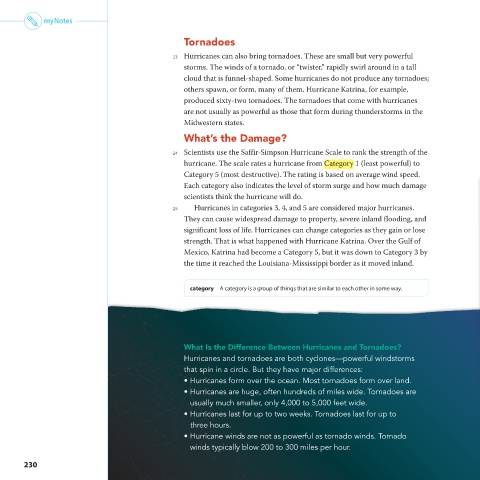Page 230 - G5.1_M1-5
P. 230
DO NOT EDIT--Changes must be made through “File info”
CorrectionKey=TX-B;NL-B
myNotes
Tornadoes
23 Hurricanes can also bring tornadoes. These are small but very powerful
storms. The winds of a tornado, or “twister,” rapidly swirl around in a tall
cloud that is funnel-shaped. Some hurricanes do not produce any tornadoes;
others spawn, or form, many of them. Hurricane Katrina, for example,
produced sixty-two tornadoes. The tornadoes that come with hurricanes
are not usually as powerful as those that form during thunderstorms in the
Midwestern states.
What’s the Damage?
24 Scientists use the Saffir-Simpson Hurricane Scale to rank the strength of the
hurricane. The scale rates a hurricane from Category 1 (least powerful) to
Category 5 (most destructive). The rating is based on average wind speed.
Each category also indicates the level of storm surge and how much damage
scientists think the hurricane will do.
25 Hurricanes in categories 3, 4, and 5 are considered major hurricanes.
They can cause widespread damage to property, severe inland flooding, and
significant loss of life. Hurricanes can change categories as they gain or lose
strength. That is what happened with Hurricane Katrina. Over the Gulf of
Mexico, Katrina had become a Category 5, but it was down to Category 3 by
the time it reached the Louisiana-Mississippi border as it moved inland.
category A category is a group of things that are similar to each other in some way.
What Is the Difference Between Hurricanes and Tornadoes?
Hurricanes and tornadoes are both cyclones—powerful windstorms
that spin in a circle. But they have major differences:
• Hurricanes form over the ocean. Most tornadoes form over land.
• Hurricanes are huge, often hundreds of miles wide. Tornadoes are
usually much smaller, only 4,000 to 5,000 feet wide.
• Hurricanes last for up to two weeks. Tornadoes last for up to
three hours.
• Hurricane winds are not as powerful as tornado winds. Tornado
winds typically blow 200 to 300 miles per hour.
230

